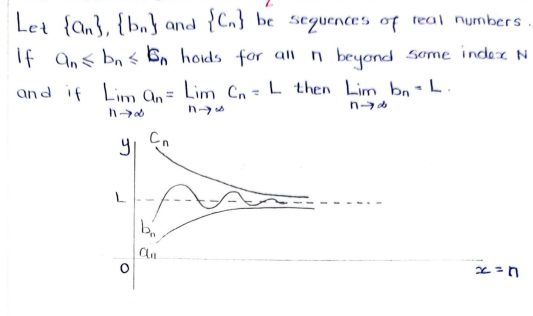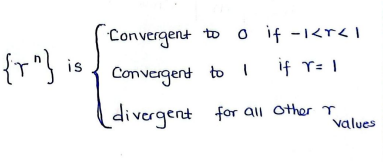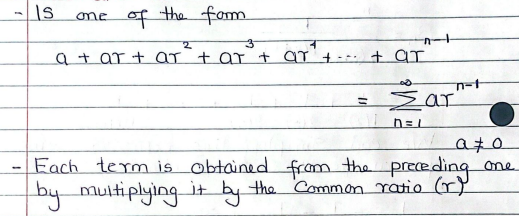Sequences and Series
1/31
There's no tags or description
Looks like no tags are added yet.
Name | Mastery | Learn | Test | Matching | Spaced |
|---|
No study sessions yet.
32 Terms
sequence
list of nums written in a specific order (increasing, decreasing, exponential increase, etc), indexed with pos, natural nums
a1, a2, a3, … an (the nums are subscripts)
notations for sequence
{an}, {an} → (infinite as superscript, “n=1” as subscript)
unless otherwise stated, assume that n starts at 1 and goes up to infinity
finding a formula for the general term of a sequence
observe how the numerator changes separate from how the denom changes
use (-1)^n for alternating neg sign
graphing sequences
input: pos natural nums (i)
output: terms of the sequence (o)
ex: (i, o) = (1,1/4), (2, 2/9)… given the general sequence term:
an = n/(n+1)²
if a limit of a sequence approaches a real num, the sequence is ____
convergent
if the limit of a sequence DNE (either approaches infinity or alternates between nums infinite times), the sequence _____
diverges

(limits of sequences rules)

the squeeze/sandwich theorem


ONLY if it’s zero

the sequence {r^n} =

monotonic sequence
a sequence that is always either increasing or decreasing
bounded sequence
a sequence where all the terms are withen a certain range (like a bounded area region)
deriv method to det if a sequence is monotone
the deriv of the sequence fn is always pos
the deriv of the sequence fn is ALWAYS neg (no matter what input value)
you can sometimes _________ the first few terms of a sequence and it would not change the limit of the sequence
discard
to det whether a sequence is strictly increasing or decreasing
even if the fn fluctuates for the first few terms, it can EVENTUALLY strictly increase/decrease
observe whether the deriv of the sequence fn f(x) is positive or negative for all x vals greater than or equal to 1
BUT it could be x vals greater than or equal to any num greater than 1 (hence, the sequence EVENTUALLY strictly decreases/increases)
sub in nums greater than 1 into the deriv and observe how the fn changes
if a sequence is eventually increasing, then either:
it has an UPPER bound that is a constant (lim exists)
it diverges to POSITIVE INFINITY
if a sequence is eventually decreasing, then either:
it has a lower bound that is a constant (lim exists)
it diverges to NEGATIVE INFINITY
bounded sequence cont’d
would have an upper bound (upper lim)
or a lower bound (lower lim)
(basically find the lim of the sequence)
for sequences w alternating sign (-1)^n, take the lim of the __________
absolute val
series
SUM of the TERMS in a seqeunce
finite vs infinite series
finite: first and last term is defined
infinite: continues indefinitely → we must look at the sequence of PARTIAL SUMS (S1, S2, S3… (the nums are subcripts)) where S2 for example represents the partial sum of the first two terms in the sequence
sum of an infinite series simple example
we make an infinite sequence made up of the partial sums (see image)
the sum is the limit of the sequence of partial sums (expression of Sn) as n approaches infinity

sequence of partial sums
Sn = general expression for the sequence of partial sums
up until n (on top of the sigma symbol) -. add up until the nth term

if the limit of the sequence of partial sums (Sn, diff from An) as n approaches infinity exists (meaning convergence), then
the series of the infinite sequence converges and comes up with a real sum.
because the SUM of the series equals to the limit of the general expression of the sequence of partial sums (Sn)
if the limit of the sequence of partial sums as n approaches infinity DNE or is infinity (meaning divergence), then
the series of the infinite sequence itself diverges
geometric series
“a” and “r” are both constant values
the series can start with a num other than “a”

geometric series: if r = 1 (the common ratio raised to the power of n)
the series simplifies to:
a + a + a + a… = na → + or - infinity, therefore divergent
Sn = na
for geometric series: if r ≠ 1
memorize the last line
for geometric series: if -1 < r < 1, then r^n → 0 as n → infinity, therefore

a geometric series is convergent if:
|r| < 1
if |r| < 1 for a geometric series, the sum =
a/(1 - r)
a geometric series is divergent if:
|r| >= 1